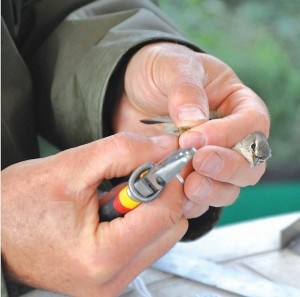
If youÔÇÖre at Pyramid beach at 4:30 a.m., chances are you have slipped on rubber bootsÔÇöthough hip waders are a better optionÔÇöand are ready to slug through swampy land to spend a day with the birds.
This is a typical routine for bird banders in Jasper National Park. Bird banding is a technique used to study and monitor wild bird species. Birds are captured in fine net and taken to a nearby tent where species, sex and approximate age are identified. Then a tiny band with a unique identification number is placed around the birdÔÇÖs leg.
Monitoring birds is key to understanding the overall health of Jasper National Park, and ultimately Canada, said Brenda Shepherd, JNP conservation biologist. The bird banding station at Pyramid beach is one of 500 bird monitoring stations across Canada.
With the MAPS bird banding program through the Friends of Jasper National Park, volunteers are given a hands-on opportunity to participate in bird banding sessions. Volunteers meet just before dawn at Pyramid beach and trek into the wetland behind the beach. This area is actually under a superintendentÔÇÖs closure, so entry is restricted to bird banders and volunteers.
The water and mud can be deep during the trek through the swamp, so rubber boots are necessary. If itÔÇÖs particularly wet, hip waders are the best bet. Warm clothes and layers are recommended as the early morning dew sets off a chill in the air.
The sound of chirping birds is a pleasant distraction from the slippery and at times pungent walk to the banding station.
Once there, the group breaks into smaller teams and works to set up the tent and 10 nets. The nets are set up, but not let down until sunrise. In the meantime, volunteers clear any greenery above and below the nets that could cause interference.
The nets are all released at the same time and then checked in 20-minute increments.
ÔÇťWe give the bottom line a little wiggle, because some [birds] are just so tiny that they are hard to see,ÔÇŁ said Shepherd while inspecting a net.
Due to the netsÔÇÖ different locations, some catch more birds than others. Hummingbirds are one species that birders donÔÇÖt want to catch in the net because their energy resources greatly depreciate while they struggle. Catching hummingbirds is avoided by hiding anything with bright colours near the nets so the bird wonÔÇÖt be attracted to it.
If a hummingbird is accidentally caught, it is released right away, said Shepherd. If the bird shows signs of fatigue, she helps it re-energize by feeding it sugar water.
Although hummingbirds arenÔÇÖt the target species in JNP, there are specialized hummingbird stations outside the park, including one in Dunster, B.C.
One of the first birds caught during the July 5 bird banding session was a varied thrush. ÔÇťWe donÔÇÖt catch this species very often,ÔÇŁ said Shepherd. The varied thrush is a stocky songbird with an eye-catching burnt orange chest and stomach.
Data collected during bird banding will be analyzed by Parks Canada and will also go to the Canadian Wildlife Service for further analysis of the countryÔÇÖs bird population.
With six bird banding dates this summer, there is still the opportunity to volunteer. The next session is listed as July 24. To sign up, email [email protected].
Sarah Makowsky
[email protected]
